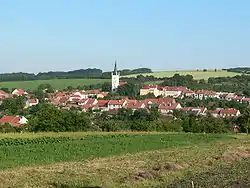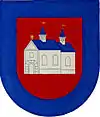Ostrožská Lhota
Ostrožská Lhota (Czech pronunciation: [ˈostroʃskaː ˈlɦota]) is a municipality and village in Uherské Hradiště District in the Zlín Region of the Czech Republic. It has about 1,500 inhabitants.
Ostrožská Lhota | |
|---|---|
 View from the north | |
 Flag  Coat of arms | |
 Ostrožská Lhota Location in the Czech Republic | |
| Coordinates: 48°58′32″N 17°28′3″E | |
| Country | |
| Region | Zlín |
| District | Uherské Hradiště |
| First mentioned | 1371 |
| Government | |
| • Mayor | Roman Tuháček |
| Area | |
| • Total | 6.35 km2 (2.45 sq mi) |
| Elevation | 207 m (679 ft) |
| Population (2020-01-01[1]) | |
| • Total | 1,480 |
| • Density | 230/km2 (600/sq mi) |
| Time zone | UTC+1 (CET) |
| • Summer (DST) | UTC+2 (CEST) |
| Postal code | 687 23 |
| Website | www |
History
The first written mention of the village comes from 1371, the reign of emperor Charles IV, when the John Henry, Margrave of Moravia passed the land of Uherský Ostroh to his son John Sobieslaus.[2] At that time, the village was called Majori Lhota (Latin for Great Lhota).
In 1421, the so far Catholic parishioners had to follow the example of their master Hašek of Waldsheim and adopt the religion of the Moravian Church. In the Hussite Wars, they fought along with the Hussites.
In 1511, John of Kunovice bought the land of Ostroh and his house later held it until the Thirty Years' War. At that time, the village was named Ostrovská Lhota, Ostrá Lhota or Kamenná Lhota (literally Stony Lhota). In 1592, the lords of Kunovice had a first register of cottars and their property made – Administrative register of the land of Ostroh of 1592. This register listed a total of 72 family farms. The following names were listed there and have been preserved up to the 20th century: Blahuš, Vaněk, Vlk, Pavelka, Štajnoch, Bachan, Hanáček, Válek, Hanák, Malušek.
After the Battle of White Mountain, the last lord of the land, John Bernard of Kunovice, escaped to Transylvania and his property was bought in 1625 by Gundakar of Liechtenstein, whose descendants held the village until 1918. At the change of the 16th and 17th century (in the years 1663, 1674, 1699, 1705), the village suffered attacks by the Kuruc, Turkish and Tatar peoples from the kingdom of Hungary and was repeatedly burned down.
An independent clerical ministry in the parish was founded in 1766 by countryman Jan Maluš, a priest in the nearby village of Blatnice pod Svatým Antonínkem, which the parish of Ostrožská Lhota had previously belonged to.
During the Austro-Prussian War of 1866, the retreating Austrian soldiers spread an epidemic of cholera into the village, which caused a death of several dozens of its inhabitants.
The present parish church dedicated to Saint James the Great was built in 1908, in place of a torn down church building from 1832, whose tower originated from the oldest known church, collapsed in 1830.
Economy
In 2007, a solar energy power plant was installed in Ostrožská Lhota, which in the time of its inauguration was the largest power plant of this kind in Central Europe, reaching an output of 702 kWp.
Sights
- Statue of St. John the Baptist from 1747
- Parochial church of St. James the Great from 1908 in a late baroque style
References
- "Population of Municipalities – 1 January 2020". Czech Statistical Office. 2020-04-30.
- Codex diplomaticus et epistolaris Moraviae 10
Further reading
- Žajdlík, Pavel; et col. (2001). Ostrožská Lhota 1371-2001 (in Czech). Ostrožská Lhota: Obecní úřad Ostrožská Lhota. pp. 64 s. il. (some colorful), maps 21 cm. ISBN 80-238-9937-6.
- Obec Ostrožská Lhota (1930–1997). Obecní kronika (in Czech). Ostrožská Lhota: Obecní úřad Ostrožská Lhota.
External links
| Wikimedia Commons has media related to Ostrožská Lhota. |